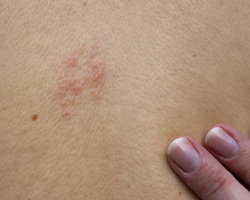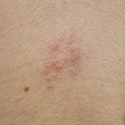What Are Shingles?
If you are over 60, chances are that your doctor has immunized you with the shingles vaccine or counseled you to get it. At least that is what the folks at the Centers for Disease Control in Atlanta hope will happen. But even the best laid medical plans go awry in our world of managed care, cost shifting, and vaccine phobia.

Your doctor may have also referred to it as the “varicella zoster vaccine” rather than the “shingles vaccine”. So what are shingles and varicella zoster? They are the same thing. They both refer to the chickenpox virus. Hence you hope to prevent shingles by getting the varicella zoster vaccine (cleverly named Zostavax by the marketing folks at Merk). Historically chickenpox and shingles have been thought of as two separate diseases. Varicella (chickenpox) afflicting the younger and shingles striking the older. It is now realized they are a manifestation of the same virus. I like to think of shingles as chickenpox “all grown up”.
Shingles is merely that chickenpox virus you had in grade school coming back out to play years later. That varicella virus has been lurking silently inside you all this time. It’s quite remarkable if you ponder it; It has traveled with you through the inventions of the microwave oven, television, Elvis, disco, and the fall of the Soviet Union. Now that you are a little older, you may have noticed your immune system isn’t what it used to be. Well so has that varicella virus. It’s been waiting ever so patiently all this time to erupt again. Stress and other illnesses are often all that is needed to let it breach your defenses.
Shingles Symptoms And Suffering
Late night talk show host David Letterman took only his second sick day in 21 years due to a shingles outbreak. To illustrate the severity of his rash, it is worth pointing out that his only other sick day was for a coronary bypass up until that time. But shingles is not a condition of the elderly alone. Anyone can get it. A healthy thirty-six year old colleague of mine has had shingles twice already for no apparent reason, underscoring the point there is much yet to learn about this virus. It is estimated that 1 in every 3 Americans will get shingles. There will be a million cases this year alone. Although the vaccine is recommended for those 60 and over, it is actually approved for use down to 50-59 by the FDA. If you have a weakened immune system from a medical condition or due to a medication, talk to your doctor about it.

Shingles usually starts as a painful, stinging, tingling or even itchy rash. Low grade fever, chills, or a headache often accompany the onset. The skin erupts in grouped blisters or angry red bumps often in a single stripe across one side of the body. I’m told it feels like a whipping. And it’s not hard to image a whip wound from a cruel master when you see it. It can take several days to develop its characteristic appearance though and can go unrecognized early in its course, especially if it happens to be painless. The blisters scab over in about 10 days and the whole event usually lasts around two weeks…if you are lucky. For some unfortunate souls, shingles is the beginning of a long odyssey of pain and frustration.
The persistence of the pain is referred to as Post Herpetic Neuralgia or PHN. The horror of PHN can rival the best of any medieval tortures. It has been described as “demons gnawing” on the skin and a continuous “stabbing with an ice pick”. One lady told me she is awakened several times a night to the feeling of scalding water being poured across her ribs.
Treating Shingles
The misery of PHN is difficult to treat as doctors often rely on power painkillers and even anti-seizure medications. Some find relief from acupuncture and traditional Chinese medicine. I sometimes recommend an over-the-counter capsaicin cream. It is the extract from a red hot chili pepper and helps “fight fire with fire”. For some patients, the daily pain of shingles is their new reality though. This easily results in depression and decreased quality of life overall. And if chronic pain wasn’t enough for you, shingles can also result in blindness, hearing loss, paralysis and even death in extreme cases.
The Shingles Vaccine
I hope by now you are asking yourself, “How can I avoid this horrid torture?” The answer is the shingles vaccine. At least that is the best answer currently. It is effective at preventing about 50% of shingles outbreaks and 66% effective at prevention of the dreaded PHN residual pain. The latter reason is the most compelling to get vaccinated in my humble opinion. Even if you’ve had shingles already, you can still get the vaccine to help prevent future episodes (although they are uncommon). It is believed the vaccine will last about 5-6 years in your system but this is a question only time will answer for us. Ninety-nine percent of Americans over 50 are estimated to have had chickenpox during childhood. The goal of the shingles shot is to prevent reactivation of this virus.
It is a “live” vaccine and contains live viral particles. So those with weakened immune systems, HIV/AIDS, or pregnant women should have a serious discussion with their doctors to weigh the risks and benefits. To date, there has been no documented spread of infection from someone receiving the vaccine to another person. But it is still a good idea to tell your doctor if someone in your household has immune system problems. Some people fear getting shingles from the vaccine since it is a “live” vaccine. Data in this regard is difficult to interpret, but I think it would be highly unlikely given personal my experience.
All Medicare Part D plans supposedly cover the shingles vaccine. However, every plan’s cost sharing (i.e. what you have to pay) differs. Most doctors don’t carry the vaccine because the significant cost means the product is likely to expire on their shelves. So we write prescriptions for it and have the patient bring it back to the office for injection at no extra charge. Medicare part B does not cover this vaccine.
So should you get the vaccine? That is akin to the question of “should I buy insurance?” Hindsight is always 20/20. There is no guarantee it will prevent shingles or the chronic pain of PHN, and the cost can be substantial. $250 seems to be the going rate for the shot. As one of my patients put it, “A $250 price tag for those on fixed incomes for something that is only 50% effective makes no sense. Great humanitarian effort Big Pharma!” While I understand his frustration, you need not meet too many people with chronic shingles pain before deciding you probably want the shot. I’m told some pharmacies have access to $138 rebate cards somewhere deep in their computer labyrinths. Some patients tell me they have to be persistent in asking.
If you can afford it, or are patient enough to pursue the rebates, I do recommend getting the vaccine. Suffering a little financial pain to potentially spare you hellish physical pain later, sounds like a good roll of the dice to me.

